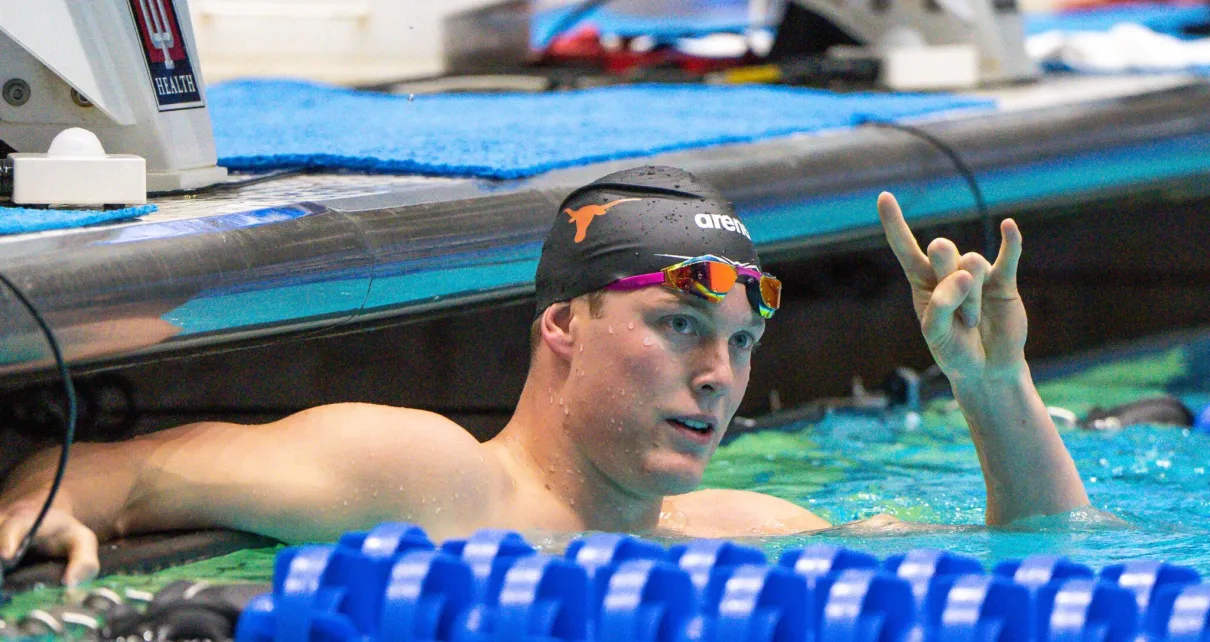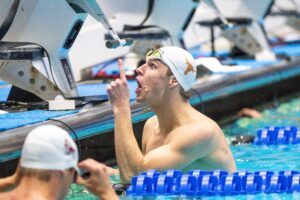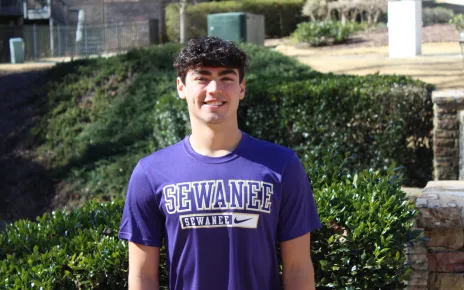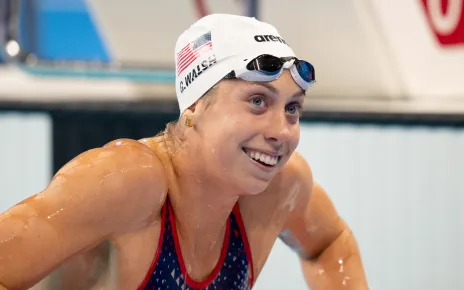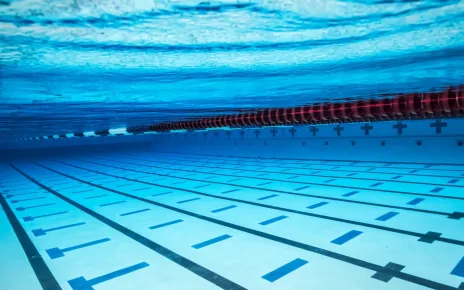UNBELIEVABLE DISCOUNTS AT AMAZON.COM ||
It’s that time of the year again. SwimSwam will be previewing the top 12 men’s and women’s teams from the 2024 NCAA Championships. Follow along with the College Swimming Preview Channel. Want to read even more? Check out the latest edition of the SwimSwam magazine.
#7 Texas Longhorns
Key Losses: Cole Crane (NCAA qualifier, 1 NCAA relay), Noah Duperre (12 NCAA diving points), Jake Foster (4 NCAA points, 2 NCAA relays)
Key Additions: # 2 Cooper Lucas (TX – IM/free), #11 Kyle Peck (VA – back/sprint free), HM Landon D’Ariano (PA – IM), BOTR Garrett Gould (NJ – sprint free), BOTR Jeremy Kelly (TX – sprint free), Hubert Kos (transfer – ASU – IM/back), Rex Maurer (transfer – Stanford – IM/free), Aaron Shackell (transfer – Cal – mid-D free), Michael Cotter (transfer NC State – free), Ben Sampson (transfer – IM/back)
Returning Fifth Years: Coby Carrozza (12 NCAA points, 1 NCAA relay)
GRADING CRITERIA
Over the years, we’ve gone back and forth on how to project points, ranging from largely subjective rankings to more data-based grading criteria based on ‘projected returning points.’ We like being as objective as possible, but we’re going to stick with the approach we’ve adopted post-Covid. The “stars” will rely heavily on what swimmers actually did last year, but we’ll also give credit to returning swimmers or freshmen who have posted times that would have scored last year.
Since we only profile the top 12 teams in this format, our grades are designed with that range in mind. In the grand scheme of college swimming and compared to all other college programs, top 12 NCAA programs would pretty much all grade well across the board. But in the interest of making these previews informative, our grading scale is tough – designed to show the tiers between the good stroke groups, the great ones, and the 2015 Texas fly group types.
- 5 star (★★★★★) – a rare, elite NCAA group projected to score 25+ points per event
- 4 star (★★★★) – a very, very good NCAA group projected to score 15-24 points per event
- 3 star (★★★) – a good NCAA group projected to score 5-14 points per event
- 2 star (★★) – a solid NCAA group projected to score 1-4 points per event
- 1 star (★) – an NCAA group that is projected to score no points per event, though that doesn’t mean it’s without potential scorers – they’ll just need to leapfrog some swimmers ahead of them to do it
We’ll grade each event discipline: sprint free (which we define to include all the relay-distance freestyle events, so 50, 100 and 200), distance free, IM, breaststroke, backstroke, butterfly and diving. Use these grades as a jumping-off point for discussion, rather than a reason to be angry.
Also, keep in mind that we are publishing many of these previews before teams have posted finalized rosters. We’re making our assessments based on the best information we have available at the time of publication, but we reserve the right to make changes after publication based on any new information that may emerge regarding rosters. If that does happen, we’ll make certain to note the change.
2023-2024 LOOKBACK
Where to begin? Might as well start with last year’s preview, which we ended by saying that “the Longhorns seem like they’re in a very real danger of falling out of the top five for the first time in some of the freshmen’s lifetimes.”
While we hate to be the agents of doom and gloom, that warning turned out to be true. With stars like Carson Foster (pro) and David Johnston (redshirt) out, and not much of a sprint core, it was going to be tough for the Longhorns in Eddie Reese’s final season.
There were certainly some bright spots, especially with the freshman class.
Will Modglin and Nate Germonprez proved to be one of the best freshman duos in the country. Modglin took down the Texas 100 back record, and he and Germonprez lopped off chunks of time in various events all season long. Camden Taylor didn’t make NCAAs individually, but he joined with Modglin and/or Germonprez on all three freestyle relays.
Meanwhile, junior Luke Hobson had a heckuva NCAAs. He and Leon Marchand both broke the all-time 200 free record on the first day, and after taking 2nd to Marchand in the 500, Hobson wrested back the 200 free record in the individual event, setting the new mark at 1:28.81.
Two days after the completion of NCAAs (coincidentally April 1st), Texas announced that former Michigan and Arizona State head coach Bob Bowman would be the new Director of Swimming. Within days of Bowman’s hire, the transfer floodgates opened. It turned out that Hubert Kos would be the only Sun Devil to follow Bowman to Austin, but former top-ranked recruits Aaron Shackell (Cal), Rex Maurer (Stanford) and Michael Cotter (NC State), as well as D3 star Ben Sampson all announced their transfers to Texas.
Although we’re focusing on the college season, it’s still worth mentioning that the Longhorns, new and old, had plenty of success this summer. Foster, Johnston, Shackell and Hobson all made the US Olympic team, and Hobson actually became the first Longhorn to medal in the 200 free, earning a bronze. Meanwhile, Kos, representing Hungary, took gold in the 200 back.
All that to say, on paper, Texas has plenty of momentum heading into the 2024-2025 collegiate season.
SPRINT FREE: ★★★
This section is going to sound a lot like last year’s preview but with a Texas-sized list of new names.
No one currently on the roster swam the 50 free at NCAAs, while only two returning swimmers contested the 100 free. The big gun was Luke Hobson, who, as we said, is now the fastest swimmer ever in the 200 (1:28.81). He’s also the fastest returner in the 100, and the only man on the team who’s been under 42 with a best time of 41.35. In between his victory in the 200 and his 11th-place finish in the 100, he accounted for all of the Longhorns points in this discipline last season.
Fifth-year Coby Carrozza is the only other returner who’s scored in this discipline. He didn’t make it out of prelims last year, going 1:32.65 for 22nd, but he hit a lifetime best of 1:31.97 from Big 12s that would’ve made the B-final, and he’s scored as recently as 2023, when he finished 8th overall. He also hit a lifetime best of 42.83 in the 100 at Big 12 Championships and then added a couple of tenths at NCAAs to finish towards the rear of the pack in prelims.
We weren’t entirely sure where the versatile Nate Germonprez would focus as a freshman last year, but he settled into an IM + sprint free niche and finished the season as the Longhorns’ #2 man in both the 100 free (42.24) and 200 free (1:33.25). He didn’t race the individual 50 free all during the season, but he reliably split sub-19 on the Longhorns’ 200 free relays. His 100 best would’ve tied for 33rd at NCAAs had he opted to contest that event instead of swimming all five Texas relays.
Texas freshmen formed the core of their sprint relay corps last season. Will Modglin focused on back and IM, but hit lifetime bests of 19.55 and 42.49 leading off Longhorn relays. Camden Taylor, meanwhile, improved from 20.42/43.72/1:36.30 to 19.58/42.53/1:33.90, with even better relay splits. He may be the Longhorns’ best chance of getting someone qualified by means of the 50 or the 100 free.
Rising junior Alec Filipovic was a solid relay contributor all season long. He set a lifetime best at Big 12s with a 19.54 50 free, and he also split a solid 42.12 anchoring the medley relay there.
We might as well give David Johnston his first-ever mention in the sprint section. From what we can tell, he’s the only man in history to have gone sub-4:09 in the 500 free and not have swum on the 4×200 at NCAAs. However, his 200 free lifetime best of 1:35.10 came from a dual meet, and he had a memorably gutsy swim on the anchor leg of the 4×200 relay at the 2024 World Championships. We’re not saying there’s no chance he swims the 200 free or the relay, but there’s not really a need for it given what the Longhorns have coming in.
Texas has long had a reputation as a 200 free factory, and that’s not likely to change anytime soon under Bowman. In fact, a relay team of transfers Hubert Kos, Rex Maurer, Aaron Shackell, and Michael Cotter would score in the 800 free relay, and the Longhorns don’t lose anyone from last year’s third-place squad.
Kos owns an individual best time of 1:33.59, and has split 1:32.20 on a flying start (along with a 41.2 anchoring a 400 free relay. The other three big freestyles transfers all own best times from high school Shackell (1:32.85), Maurer (1:33.54), and Cotter (1:33.80). Both Maurer and Cotter bring additional 50/100 depth. Cotter owns lifetime bests of 20.19/43.55 and Maurer 19.77/43.28, so it’s certainly conceivable they could find their ways on the shorter freestyle relays as well.
Jackson Huckabay returns from a medical redshirt with a 200 free best time of 1:34.38, and junior Kobe Ndebele has been 19.76/43.10/1:34.48, putting him within striking range of some relay consideration.
While the freshman class doesn’t include anyone who’s a slum-dunk bet to qualify for NCAAs or crack Longhorn relays this year, they’ve got a strong trio that could form the core of the sprint relays down the road. That group includes Kyle Peck (19.74/43.66/1:37.13), Jeremy Kelly (20.02/43.67/1:36.10), and Garrett Gould (19.92/43.55).
Additionally, Cooper Lucas is one of those guys who’s just all-around fast, and arrives with times of 20.86/43.52/1:34.69, while Max Hatcher (21.19/45.78/1:36.40) and Luke Stibrich (21.19/44.82/1:36.94) are more distance-oriented, but with solid sprint times.
Just in case you weren’t keeping track, the Longhorns have 11 men under 1:35 in the 200 free, and that doesn’t even include David Johnston.
Despite all that impressive influx of depth, it’s worth remembering that it took 19.04/41.74/1:32.15 to earn a second swim in the sprint freestyles last year. Right now, Hobson and Carrozza are the only guys on this team with scoring times in any of these events, so this remains a three-star group, with the potential for a huge explosion, especially in the 200 free.
DISTANCE FREE: ★★★★★
The 500 free was the Longhorns’ strongest event last year, with a pair of A-finals from Luke Hobson (2nd) and Coby Carrozza (7th).
It’s about to get even stronger. David Johnston returns after redshirting and making the US Olympic team in the 1500. He’s a two-time A-finalist in the 500 free, and he’s finished between 4th and 7th each of his three NCAA appearances in the 1650.
As if that’s not enough, the Longhorns add additional star power with Rex Maurer (4:11.88), Aaron Shackell (4:15.35), and Cooper Lucas (4:14.53). Shackell won the 400m free at the Olympic Trials and ultimately placed 8th in the final in Paris.
Are they going to put six men into the finals? Maybe not, but you’ve got to like their chances, especially if/when Jackson Huckabay, who missed last season due to medical issues, returns after going from 4:26.36 to 4:16.31 as a freshman/sophomore in 2022-2023.
We’ll note here that Alec Enyeart, who qualified for NCAAs as a freshman, but missed the cut time last year as a sophomore, now appears to be off the roster.
Freshmen Max Hatcher (4:21.55/15:48.64) and Luke Stibrich (4:24.34) add some distance depth. Lucas has been 15:41.13, but if we had to guess right now, it looks like he may opt for the 200 fly.
BACKSTROKE: ★★★★★
Will Modglin had a stellar debut season for the Longhorns, becoming Texas’ first two distance scoring threat in this discipline since the days of John Shebat and Austin Katz. He rapidly improved from 45.01/1:40.54 to 44.20/1:38.85. That 100 time eclipsed Shebat to make him the fastest Longhorn ever, with another three years to go.
However, Modglin’s mark may not survive long. Hubert Kos had a dynamic Pac-12 championship meet for ASU last year, blasting times of 43.75 and 1:35.69. That latter time set the all-time yards record before Destin Lasco re-set the mark a few weeks later at NCAAs, while his 100 back time puts him at #9 all-time. Oh yeah, he’s also won gold in the 200 back at the summer’s biggest international meets each of the last two years.
But wait, there’s more. Transfers Rex Maurer and Ben Sampson add scoring potential as well. Maurer’s been 45.40/1:39.75. That 100 time came while leading off Stanford’s 400 medley at Pac-12s. The 200 back time came from midseason, and it would’ve been good enough to make the B-final at NCAAs. Sampson’s been a tick slower (45.88/1:40.34), so while he doesn’t have scoring times in either event, he’s not far off, especially in the 200.
It’s tough to believe that less than two years ago, Carson Foster was leading off Texas’ relays. Next year, they’ll have at least five guys under 46, as freshman Kyle Peck arrives with bests of 45.68 and 1:42.71. Additionally, Jeremy Kelly owns a 47.75 100 time along with a 1:47.75 in the 200.
Multi-time NCAA qualifier Christopher O’Connor isn’t on the roster this year, but they bring back Nathan Quarterman, who clocked a lifetime best of 1:41.71 late in the 2022-2023 and then didn’t race after October last season.
BREASTSTROKE: ★
Last year, Nate Germonprez came in with breaststroke times that put him at the top of the depth chart…and then didn’t contest the discipline all that much.
Meanwhile, fellow freshman Will Scholtz improved from 53.61/1:56.72 to 52.09/1:53.70. At Big 12s, he put up relay splits of 23.17/51.65 that were virtually identical to Jake Foster’s relay splits at NCAAs. So, unless Germonprez switches focus back to breast, Scholtz may be the leading candidate for relay duty.
Yet another freshman, Brayden Taivassalo, had a solid rookie season, putting up bests of 52.28/1:53.28. That latter time makes him the Longhorns’ top returning performer in the discipline.
Among incoming freshmen, the ever-versatile Cooper Lucas has been 54.18/1:56.32, but will probably focus on other events, and Jeremy Kelly has been 54.98. Those are solid times, but don’t change the fact that any breaststroke qualifications and relay swims are likely to come from the aforementioned trio are
BUTTERFLY: ★
We’re coming up on the tenth anniversary of that legendary moment when the Longhorns put six men into the 100 fly A-final at the 2015 NCAAs…and there’s a very real risk they may not have anyone swimming the event at the NCAAs this year.
Sam Artmann and Cole Crane are gone, leaving Alec Filipovic (46.18) as the top returner, but still a ways away from last year’s cut time of 45.37. He’s also been 1:43.43 in the 200.
Help may be on the way, in the form of two backstrokers. Kyle Peck arrives with a best of 46.99. The more intriguing prospect, however, is one Hubert Kos. He’s been 45.59 in yards and 50.84 in LCM, with both of those times coming in in-season meets, so it’s reasonable to assume Kos could swim 44-something comfortably in yards. He raced the 400 IM as a freshman, then shifted to the 100 back last season. It’s tough to assess how likely he is to make another event lineup change, but you have to think he’s at least in the mix for a relay spot.
Rising junior Ryan Branon chipped a little more time off of his 200 fly last year, improving from 1:43.17 to 1:42.70. is knocking on the door of an NCAA invite in the 200 after improving to 1:43.17 last season. Classmate Holden Smith is the other strong two-distance flyer, having gone 46.67/1:44.79 last year.
IM: ★★★★★
Last year, we had to give this discipline a single star after losing all of their 2023 scorers. This year, this might be one of the best groups in the nation.
Nate Germonprez and Will Modglin each knocked two seconds off their 200 IM best times last year. Germonprez’s came in with a 1:42.82 and ultimately improved to 1:40.89, good for 7th at NCAAs. Modglin’s went from 1:43.37 to 1:41.01, but couldn’t match that time at NCAAs, finishing 29th with a 1:43.29. He had strong swims the rest of the meet, so look for him to bounce back and be a scoring threat this season.
Alec Filipovic went from 1:44.60 to 1:43.44 last year, less than half a second away from what it took to qualify for NCAAs.
Freshmen, transfers, and returning red shirts could theoretically add another six scoring swims.
Hubert Kos is the 6th-fastest man ever in the 200 IM and is tied as 7th-fastest ever in the 400. Even if he doesn’t swim the latter event, he should be a lock for one A-final.
David Johnston returns from his redshirt season having made the A-final in the 400 IM in each of three NCAA championships so far.
Rex Maurer didn’t score last year, but his best time (3:38.10) is good enough to make the A-final. Freshman Cooper Lucas owns bests of 1:43.88/3:41.15, and while he’ll probably swim the 500 free over the 200 IM, he’s one of the rare men who arrive to college with a NCAA-scoring time in the 400.
Fifth year Ben Sampson transfers in from Colorado Mesa University with Division I scoring times of 1:41.92/3:40.22. Both of those times would’ve earned Sampson a spot in the B-final last year.
All told, it’s not unreasonable to suggest that the Longhorns could get four scoring swims in each IM event
DIVING: ★★½
Historically a strength for the Longhorns, the diving program hasn’t racked up quite as many points the last few years as they have before. They lose Noah Duperre and his 12 points to graduation, along with NCAA qualifier Brendan McCourt.
However, they do bring their top scorer, Nick Harris, who earned 13 points across two events last year as a sophomore. s Sophomores Tanner Braunton, who picked up a point in the platform event last year, and Pierce Brooke, who placed 28th on the platform at NCAAs return. Rising senior Manuel Borowski also returns after qualifying for NCAAs on the 3m last season, placing 42nd.
The diving squad grows this year with the addition of freshmen Jacob Jones, Luke Forester, and Jacob Welsh. The latter two have international experience, highlighted by Welsh’s gold medal at the 2023 Pan American Games.
RELAYS: ★★★★
Last year, Texas only scored 82 points via relays, averaging out to 16.4 points per relay, or between 9th and 10th, in terms of finish.
Texas’ 200 free relay of Will Modglin (19.54), Nate Germonprez (18.83), Cole Crane (19.08) and Camden Taylor (19.13) failed to score, finishing 19th with a 1:16.58. No one who Texas brought in is guaranteed to substantially move the needle, although putting Luke Hobson and an 18-mid split back on this relay would’ve moved them up to about 12th last year. There are a ton of guys in the 19-mid range, so it’ll be interesting to see who can develop into the reliable sub-19 split this relay could use.
The 400 free relay is in better shape, as all four legs from last year’s 12th-place NCAA finish return: Germonprez, Luke Hobson, Modglin, and Taylor. Those were the fastest four men on the team last year in the individual 100, with times ranging from 41.24 to 42.53. Hubert Kos seems like the most likely newcomer to make an impact on this relay after splitting 41.25 on ASU’s ‘B’ relay at Pac-12s. That, plus some continued development by the sophomore trio, could help put the Longhorns in position to make the top 8.
Even in a bit of a down year, the Longhorns had a very strong 800 free relay. Veterans Hobson and Coby Carrozza combined with Germonprez and Taylor to take 3rd in 6:05.33. All four legs return, which gives the Longhorn a very solid floor, and the ceiling is even higher as Kos, Michael Cotter, Rex Maurer, and Aaron Shackell should all vie for spots on this relay as well.
The medley relays probably aren’t going to be threats to win titles, but they should be better than last year’s 8th and 9th place finishes. The only leg they lose is Jake Foster, who swam breast at NCAAs, but Will Scholtz’s Big 12 splits of 23.17/51.65 were identical to Foster’s NCAA splits (23.15/51.66). Go ahead and pencil in Scholtz for the moment.
Will Modglin‘s been 20.49/44.20 on backstroke, but could he lose his relay spot to Kos, who’s even faster? Possibly, but on paper, it looks like there’s a strong chance Kos could end up on butterfly. He’s “only” been 45.59 in the 100, but As some of our commenters were discussing recently, that was an untapered time. Additionally, he took his Pac-12 200 IM out in 20.42. Subtract half a second for a flying start, and that put Kos comfortably under 20.0, even without assuming he’d be pushing harder on a 50. With an untapered sub-51 LCM 100 fly and a sub-44 SCY 100 back, he’s probably a safe bet for at least a 44-low fly leg on the longer medley relay.
Germonprez somewhat unexpectedly filled those fly slots last year, splitting 19.82 at Big 12s and then 20.08/45.59 at NCAAs. Moving Kos to fly frees Germonprez to either move to breaststroke (where he’s surely improved his 52.59 from two years ago), or reduce his relay load and focus on the free relays. Last year he doubled the 200 medley and 800 free relays, as did Hobson.
Total Stars: 26.5/40
2024-2025 OUTLOOK
With a new coaching staff since the first time in the swimmers’ (and possibly even some of their parents’) lifetimes, and an incredible influx of talent, the eyes of the swimming world will be on Texas this year.
One interesting thing to note is that this will be the season the Longhorns compete in the SEC. That means this will be the first time in a very long time that they’ll have a challenge if they want to win the conference title. Bowman doesn’t seem like the type who will let a mere conference championship distract from the bigger stage, but it’ll still be interesting to see if/how a conference slugfest affects Texas’ traditional approach to the end of the season.
Our discipline rankings help tell the story of what to expect from Texas. They should rack up points in the 200 free, distance freestyle, IM, and backstroke, but the 50/100 free, breast, and fly are all in danger of not scoring at all. They’ll pull in some points from diving, and the relays will be solid if not spectacular. That all adds up to a very strong team that probably has a few too many holes to realistically challenge for the NCAA title.
In a recent poll, roughly 1/3 of our respondents picked Texas to win this year. That’s probably an unrealistic expectation. Even if the Longhorns were to double their points from 189 to 378, that only would’ve put them in a tie for 3rd with Florida last year.
Mathematically, if everything was to go nearly flawlessly at NCAAs, could Texas go 15/10 individually, eke out 30 diving points, and average 8th place across the relays? Sure, and if so, that would probably put them in the hunt for the team title. Is that super realistic? Probably not. More likely, the Longhorns double their point total, make a run at the top 4, and continue to build from there after 2025.
MEN’S PREVIEW INDEX:
| Team | Sprint Free | Distance Free | Backstroke | Breaststroke | Butterfly | IM | Diving | Relays | Total Stars |
| #7 Texas Longhorns | ★★★ | ★★★★★ | ★★★★★ | ★ | ★ | ★★★★★ | ★★½ | ★★★★ | 26.5/40 |
| #8 Stanford Cardinal | ★★½ | ★★ | ★★ | ★★★ | ★★★½ | ★★★ | ★★★½ | ★★★★ | 23.5/40 |
| #9 Virginia Tech Hokies | ★★★ | ★ | ★★ | ★★★ | ★★★ | ★★★ | ★ | ★★★½ | 19.5/40 |
| #10 Notre Dame Fighting Irish | – | – | – | – | – | – | – | – | Suspended |
| ★ | ★★★ | ★★★ | ★ | ★★★★ | ★★★★ | ★ | ★★★ | 20/40 | |
| #12 Auburn Tigers | ★½ | ★★★ | ★★½ | ★★ | ★ | ★★½ | ★ | ★★★½ | 17/40 |

